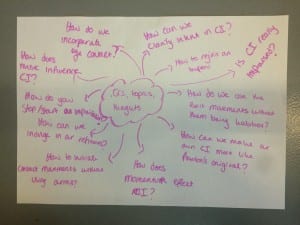Research Lab
I was looking forward to this weeks’ lesson as it was our first chance as a class, to gain a better understanding of contact by exploring different elements of it. By getting in to groups we came up with aspects of contact improvisation and see what needs further work. The research labs gave us time to pick few topics that we’d like for our class to work on, and see what the outcome would be and if it would open their eyes and opinions of contact.
Most groups chose to focus on eye contact, including us. I feel this may be because as a whole we don’t have the discipline to keep eye contact without breaking it; whether it would be through nervous laughter or just the uncomfortable feeling of looking at someone straight in the face. I was a little worried because of the similar topic whether we would be able to achieve the outcome we’d hope for; being able to contact improvise and incorporate eye contact to build a stronger relationship between partners.
As our group went last I got to experience the other’s methods on developing eye contact. Some we’re interesting and some were difficult for me and one in particular was a task to find a partner and sit back to back with our eyes shut and improvise and every few minutes change partners still keeping the eyes closed. Having to reflect back on this task I realized that it was good when you found a strong connection but then having to build that relation all over again with a new person in a short amount of time, especially with the eyes shut was constricting. I didn’t know if I was going to the same people and if it didn’t feel right I would just lie on the floor hoping they would do something interesting, for me to follow through with. What I do know is that I feel a lot more comfortable improvising with my eyes shut, it makes me feel more in tuned with my movements and not as self-conscious.
When it came to explore our questions with the rest of the class I was quite excited, because I personally wanted to know whether they would experience the same thoughts we did, while going through to process.
How do we incorporate eye contact?
It’s our first question for the task and the way we have done this is to get in to pairs and stare at them straight and without breaking concentration, just placing the hands on different parts of the body. While observing them starting the task we could see people trying to concentrate which was good for them because this is a build-up exercise to help them become comfortable. The development from this is to start moving while keeping the eye contact, then to slowly build a small duet. After that get together with another pair and perform a piece while keeping contact and get feedback from the observing pair.
The feedback we received from this task was quite positive, the groups appreciated that we started off small to build up the focus because it gave them a stronger connection while improvising, which also led them to think creatively and as an observer I could see this and was interested in how each pair would flow. A few did mention that while swapping between pairs it was hard to establish the initial connect back again, which meant that they also felt like they wanted to stay in the pairs longer just to explore.
How can we clarify intent?
This task is to see as a class whether we could feel the connection between partners on who initiates coming out of a weight baring position. As a class we presumed that the under dancer would initiate as they are the one holding all the weight and who would take on the role as under and over dancers. We told the class to get into pairs and just find 3 positions that they could manage and to be the under dancer at least once. When this is done the over dancer then decides when to initiate coming out of the position and the same for the under dancer, repeating the position twice.
From this task the feedback we received was something we anticipated prior to the lesson, as a majority they felt confident in holding their weight but also acknowledging that the under dancer is a lot more capable, only when planted in the position. They did feel as though there shouldn’t have been a build-up for this task because during lessons we wouldn’t get the chance to plan lifts; in spite of this they did come up with unique lifts with the time they had and enjoyed exploring them.
Hackney, P. (2002) ‘What Are Principles of Bartenieff Fundamentals?’ in Making Connections: Total Body Intergration Through Bartenieff Fundamentals. London: Routledge.
Lepkoff, D. (1999) What is Release Technique? Daniel Lepkoff. Available from http://www.daniellepkoff.com/Writings/What%20is%20Release.php. [Accessed 27/10/2015]

